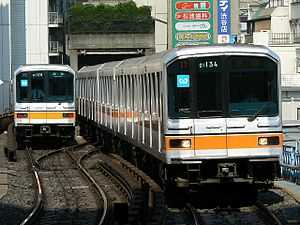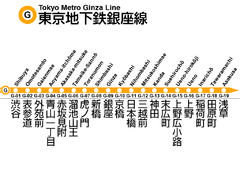Tokyo Metro Ginza Line
| Tokyo Metro Ginza Line | |||
|---|---|---|---|
|
| |||
|
Ginza Line 01 series EMUs at Shibuya Station | |||
| Overview | |||
| Type | Heavy rail rapid transit | ||
| Locale | Tokyo | ||
| Termini |
Shibuya Asakusa | ||
| Stations | 19 | ||
| Daily ridership | 1,006,102 (2010)[1] | ||
| Operation | |||
| Opening | December 30, 1927 | ||
| Owner | Tokyo Metro | ||
| Depot(s) | Shibuya, Ueno | ||
| Rolling stock | Tokyo Metro 01 series, Tokyo Metro 1000 series | ||
| Technical | |||
| Line length | 14.3 km (8.9 mi) | ||
| Track gauge | 1,435 mm (4 ft 8 1⁄2 in) standard gauge | ||
| Electrification | 600 V DC, third rail | ||
| Operating speed | 65 km/h (40 mph) | ||
| |||
The Tokyo Metro Ginza Line (東京地下鉄銀座線 Tōkyō Chikatetsu Ginza-sen) is a subway line located in Tokyo, Japan. It is part of the of Tokyo Metro network. The official name is Line 3 Ginza Line (3号線銀座線 3-gōsen Ginza-sen). It is 14.3 km long and serves the wards of Shibuya, Minato, Chūō, Chiyoda, and Taitō. The line holds the distinction of being the oldest subway line in Asia.[2]
On maps, diagrams and signboards, the line is shown using the color orange, and its stations are given numbers using the letter G.
Operations
Almost all Ginza Line trains operate on the line's full length from Asakusa to Shibuya. However, two trains depart in the early morning from Toranomon, and some late-night trains from Shibuya are taken out of service at Ueno.
On weekdays, trains run every two minutes in the morning peak, every 2 minutes and 15 seconds in the evening peak, and every 3 minutes during the daytime. The first trains start from Shibuya and Asakusa at 05:01, and the last ones reach Shibuya at 00:37, and Asakusa at 00:39.
Station list
| Route map | ||||||||||||||||||||||||||||||||||||||||||||||||||||||||||||||||||||||||||||||||||||||||||||||||||||||||||||||||||||||||||||||||||||||||||||||||||||||||||||||||||||||||||||||||||||||||||||||||||||||||||||||||||||||||||||||||||||||||||||||||||||||||||||||||||||||||||||||||||||||||||||||||||||||||||||||||||||||||||||||||||||||||||||||||||||||||||||||||||||||||||||||||||||||||||||||||||||
|---|---|---|---|---|---|---|---|---|---|---|---|---|---|---|---|---|---|---|---|---|---|---|---|---|---|---|---|---|---|---|---|---|---|---|---|---|---|---|---|---|---|---|---|---|---|---|---|---|---|---|---|---|---|---|---|---|---|---|---|---|---|---|---|---|---|---|---|---|---|---|---|---|---|---|---|---|---|---|---|---|---|---|---|---|---|---|---|---|---|---|---|---|---|---|---|---|---|---|---|---|---|---|---|---|---|---|---|---|---|---|---|---|---|---|---|---|---|---|---|---|---|---|---|---|---|---|---|---|---|---|---|---|---|---|---|---|---|---|---|---|---|---|---|---|---|---|---|---|---|---|---|---|---|---|---|---|---|---|---|---|---|---|---|---|---|---|---|---|---|---|---|---|---|---|---|---|---|---|---|---|---|---|---|---|---|---|---|---|---|---|---|---|---|---|---|---|---|---|---|---|---|---|---|---|---|---|---|---|---|---|---|---|---|---|---|---|---|---|---|---|---|---|---|---|---|---|---|---|---|---|---|---|---|---|---|---|---|---|---|---|---|---|---|---|---|---|---|---|---|---|---|---|---|---|---|---|---|---|---|---|---|---|---|---|---|---|---|---|---|---|---|---|---|---|---|---|---|---|---|---|---|---|---|---|---|---|---|---|---|---|---|---|---|---|---|---|---|---|---|---|---|---|---|---|---|---|---|---|---|---|---|---|---|---|---|---|---|---|---|---|---|---|---|---|---|---|---|---|---|---|---|---|---|---|---|---|---|---|---|---|---|---|---|---|---|---|---|---|---|---|---|---|---|---|---|---|---|---|---|---|---|---|---|---|---|---|---|---|---|---|---|---|---|---|---|---|---|---|---|---|---|---|---|---|---|---|---|---|
Legend
| ||||||||||||||||||||||||||||||||||||||||||||||||||||||||||||||||||||||||||||||||||||||||||||||||||||||||||||||||||||||||||||||||||||||||||||||||||||||||||||||||||||||||||||||||||||||||||||||||||||||||||||||||||||||||||||||||||||||||||||||||||||||||||||||||||||||||||||||||||||||||||||||||||||||||||||||||||||||||||||||||||||||||||||||||||||||||||||||||||||||||||||||||||||||||||||||||||||
Being the oldest line on the Tokyo Metro, stations are also the closest to the surface—generally no more than one and a half stories underground. The western end of the line emerges to the surface and enters Shibuya Station located on the third-floor of a building that is located in a depression.
| Station No. |
Station | Japanese | Distance (km) | Transfers | Ward | |
|---|---|---|---|---|---|---|
| Between stations |
From G-01 | |||||
| G-01 | Shibuya | 渋谷 | - | 0.0 | Yamanote Line, Saikyō Line, Shōnan-Shinjuku Line Tōkyū Den-en-toshi Line, Tōkyū Tōyoko Line Keiō Inokashira Line |
Shibuya |
| G-02 | Omotesandō | 表参道 | 1.3 | 1.3 | Minato | |
| G-03 | Gaiemmae | 外苑前 | 0.7 | 2.0 | ||
| G-04 | Aoyama-Itchōme | 青山一丁目 | 0.7 | 2.7 | ||
| G-05 | Akasaka-Mitsuke | 赤坂見附 | 1.3 | 4.0 | ||
| G-06 | Tameike-Sannō | 溜池山王 | 0.9 | 4.9 | Chiyoda | |
| G-07 | Toranomon | 虎ノ門 | 0.6 | 5.5 | Minato | |
| G-08 | Shimbashi | 新橋 | 0.8 | 6.3 | Yamanote Line, Keihin-Tōhoku Line, Tōkaidō Main Line, Yokosuka Line Yurikamome | |
| G-09 | Ginza | 銀座 | 0.9 | 7.2 | Chūō | |
| G-10 | Kyōbashi | 京橋 | 0.7 | 7.9 | ||
| G-11 | Nihombashi | 日本橋 | 0.7 | 8.6 | ||
| G-12 | Mitsukoshimae | 三越前 | 0.6 | 9.2 | Sōbu Line (Rapid) (Shin-Nihombashi) | |
| G-13 | Kanda | 神田 | 0.7 | 9.9 | Chūō Line (Rapid), Keihin-Tōhoku Line, Yamanote Line | Chiyoda |
| G-14 | Suehirochō | 末広町 | 1.1 | 11.0 | ||
| G-15 | Ueno-Hirokōji | 上野広小路 | 0.6 | 11.6 | Taitō | |
| G-16 | Ueno | 上野 | 0.5 | 12.1 | Tōhoku Shinkansen, Akita Shinkansen, Yamagata Shinkansen, Jōetsu Shinkansen, Nagano Shinkansen, Keihin-Tōhoku Line, Yamanote Line, Jōban Line, Takasaki Line, Tōhoku Main Line (Utsunomiya Line) Keisei Main Line (Keisei-Ueno) | |
| G-17 | Inarichō | 稲荷町 | 0.7 | 12.8 | ||
| G-18 | Tawaramachi | 田原町 | 0.7 | 13.5 | Tsukuba Express (Asakusa) | |
| G-19 | Asakusa | 浅草 | 0.8 | 14.3 | Tobu Skytree Line Tsukuba Express[* 2] | |
- ↑ Due to the distance between the Ginza and Hanzōmon/Den-en-toshi lines at Shibuya, transfers between the two lines are announced at Omotesandō.
- ↑ The Tsukuba Express station is located 600 meters to the west of this station.
History
The Ginza Line was conceived by a businessman named Noritsugu Hayakawa, who visited London in 1914, saw the London Underground and concluded that Tokyo needed its own underground railway. He founded the Tokyo Underground Railway (東京地下鉄道 Tōkyō Chika Tetsudō) in 1920, and began construction in 1925.
The portion between Ueno and Asakusa was completed on December 30, 1927 and publicized as "the first underground railway in the Orient". Upon its opening, the line was so popular that passengers often had to wait more than two hours to ride a train for a five-minute trip.
On January 1, 1930, the subway was extended by 1.7 km to temporary Manseibashi Station, abandoned on November 21, 1931 when the subway reached Kanda, 500 meters further south down the line. The Great Depression slowed down construction, but the line finally reached its originally planned terminus of Shinbashi on June 21, 1934.
In 1938, the Tōkyō Rapid Railway (東京高速鉄道 Tōkyō Kōsoku Tetsudō), a company tied to the predecessor of today's Tokyu Corporation, began service between Shibuya and Toranomon, later extended to Shinbashi in 1939. The two lines began through-service interoperation in 1939 and were formally merged as the Teito Rapid Transit Authority ("Eidan Subway" or "TRTA") in July 1941.
The "Ginza Line" name was applied in 1953 to distinguish the line from the new Marunouchi Line. In the postwar economic boom, the Ginza Line became increasingly crowded. The new Hanzōmon Line began to relieve the Ginza Line's traffic in the 1980s, but the Ginza Line is still quite crowded as it serves major residential, commercial, and business districts in central Tokyo. According to a June 2009 Tokyo Metropolitan Bureau of Transportation survey, the Ginza Line is the seventh most crowded subway line in Tokyo, running at 168% capacity between Akasaka-Mitsuke and Tameike-Sannō stations.[3]
The newest station on the line, Tameike-Sannō Station, opened in 1997 to provide a connection to the newly built Namboku Line.
Rolling stock
- 01 series 6-car EMUs
- 1000 series 6-car EMUs, since April 2012
The Ginza Line uses a total of 38 six-car 01 series EMUs which have a maximum speed of 80 km/h. Each car is 16 m long and 2.6 m wide, with three doors on each side. Both the Ginza Line and the Marunouchi Line run on 1,435 mm (4 ft 8 1⁄2 in) standard gauge, powered by a 600 V DC third rail, while the other Tokyo Metro lines run on narrow gauge (1,067 mm (3 ft 6 in)) rails and use 1,500 V DC overhead.
New 1000 series EMUs entered service on the line from April 2012.[4]
Cars are stored and inspected at Shibuya Depot located after Shibuya Station and at Ueno Inspection Division (上野検車区 Ueno-kensha-ku), a facility located northeast of Ueno Station with both above-ground and underground tracks. The facility is capable of holding up to 20 6-car formations. Major inspections are carried out at Tokyo Metro's Nakano depot on the Marunouchi Line, forwarding over a connecting track at Akasaka-Mitsuke.
Former rolling stock
- 100 series (1938–1968)
- 1000 series (1927–1968)
- 1100 series (1930–1968)
- 1200 series (1934–1986)
- 1300 series (1949–1986)
- 1400 series (1953–1985)
- 1500 series (1954–1986)
- 1500N series (1968–1993)
- 1600 series (1955–1986)
- 1700 series (1956–1986)
- 1800 series (1958–1986)
- 1900 series (1958–1987)
- 2000 series (1958–1993)
-

One of the original 1000 series cars operated on the Tokyo Underground Railway between Ueno and Asakusa. The last car was retired in 1968.
-

Original 1000 series car preserved at Tokyo Subway Museum
-

A Ginza Line 2000 series set in 1977
-

Tokyo Metro 1000 series, April 2012
References
- Shaw, Dennis and Morioka, Hisashi, "Tokyo Subways", published 1992 by Hoikusha Publishing
- ↑ Tokyo Metro station ridership in 2010 Train Media (sourced from Tokyo Metro) Retrieved May 28, 2012.
- ↑ "Diagnosis of Ginza Line Subway Tunnel, the Oldest in Asia, by Acquiring Data on Deterioration Indices". IOS Press. Retrieved 22 August 2014.
- ↑ Metropolis, "Commute", June 12, 2009, p. 07. Capacity is defined as all passengers having a seat or a strap or door railing to hold on to.
- ↑ 銀座線に新型車両1000系を導入 [New 1000 series trains to be introduced on Ginza Line] (PDF). News release (in Japanese). Tokyo Metro. 17 February 2011. Retrieved 18 February 2011.
External links
| Wikimedia Commons has media related to Tokyo Metro Ginza Line. |
- Ginza Line overview (Tokyo Metro) (Japanese)

